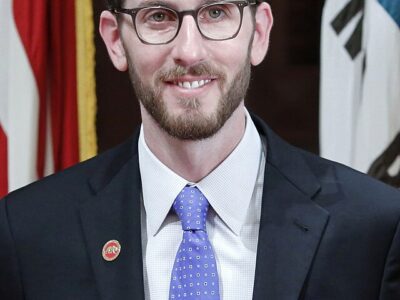Debunking stereotypes about sprawl and Los Angeles: Be Precise!
Eric A. Morris over at Freakonomics is challenging readers to debunk fashionable stereotypes (often promoted by the jealous folks from the Bay Area) about Los Angeles and sprawl. On Monday, he made clear what planning folks have known for a long time: LA is actually quite a dense city.
But be careful how you ask your questions. The stereotype Morris listed was “Los Angeles has developed in a low-density, sprawling pattern.”
As we lawyers would say: “Objection. Compound question.” Los Angeles is high-density, but it also sprawls, creating formidable land use and transportation problems.
As you can see, Morris’ other stereotypes have some of the same problems, although his answers will be worth reading. They are plagued with compound assertions as well as vagueness:
1. Angelenos spend more time stuck in traffic than any other drivers in the nation.2. Los Angeles’s mass-transit system is underdeveloped and inadequate.
3. Thanks to the great distances between far-flung destinations, and perhaps to Angelenos’ famed “love affair” with the car, Angelenos drive considerably more miles than most Americans.
4. Los Angeles’s air is choked with smog.
5. Los Angeles is dominated by an overbuilt freeway system that promotes autodependence.
Here are my answers, most of which focus on the ambiguity:
1) Probably not true, but misleading. Atlanta’s traffic might well be worse, and other cities that did not build roads as much as us might spend more time stuck in traffic. But it’s misleading because if it’s not true, it hardly suggests that traffic isn’t a problem here — just not the worst in the country. That’s a low bar.
2) Not true, but misleading. Los Angeles has the most developed bus system in the country: the MTA runs literally hundreds of buses every day, and that doesn’t include other bus systems, such as Santa Monica, Culver City, and Foothill transit. But that’s not the point. The question is whether public transit is adequate to the needs of potential riders. The subway doesn’t go anywhere, and the bus service will get less reliable as funding cuts kick in (thanks to the faux moderates in Congress and transit-hating Larry Summers). Moreover, for middle-class riders, bus service is inconvenient, which really is the touchstone.
3) Not true. Rural drivers might drive more, and those in newer, and more far-flung exurbs probably drive more. The weasel word here is “Angelenos”: who counts? What about someone who lives in the region, but not in the city? If you’re stuck on the 405, it doesn’t really matter to you if the cars around you are from Santa Clarita or Palmdale.
4) True, but void for vagueness. I don’t know what it means to be “choked” with “smog.” The air in Los Angeles is far, far better than it used to be, in large part due to Clean Air Act mandates. Moreover, most people think “smog” means particulates, but in EPA parlance, it means ozone: I don’t know which one Morris is using. But the south coast air basin remains the only one nationally that consistently receives “extreme nonattainment” status. Houston, San Joaquin, and other air basins are catching, up, tough: perhaps they have gone as extreme as LA. That’s a kind of X Games I don’t want to win.
5) Not true, but misleading. It’s hard to say that LA’s freeway system is “overbuilt” when the city hasn’t built a new freeway in decades. And as Scott Bottles demonstrates in his wonderful book Los Angeles and the Automobile, the city as auto dependent long before the freeways came in. That said, the freeways certainly assisted in promoting the idea that we could build our way out of traffic, and they are constructed in such a way as to make rail lines down the middle of them virtually impossible.
I’m looking forward to see how Morris answers the questions, and in a lot of ways, he is asking the right ones. But let’s make them more precise!
Cross-posted at the Reality-Based Community: www.samefacts.com
Reader Comments
3 Replies to “Debunking stereotypes about sprawl and Los Angeles: Be Precise!”
Comments are closed.






Re: question number 2, the LA MTA operates 73 miles of rail transit, compared to 104 miles of track for the Bay Area’s BART system. The problem is that LA is so spread out that most people will never feel the benefits of rail transit in the region. The bus system in LA, as Jonathan mentions, is comprehensive and massive. But to many middle class folks, bus doesn’t really count as mass transit.
Re: the answer to #5, the Century Freeway and the 210 by Pasadena do have rail transit down the middle, and some of the BART system travels down the middle of freeways. However, these are unfortunate places to locate rail transit as it makes developing the land areas around the station less possible and also subjects patrons to some pretty brutal air and noise treatment.
Rail lines down the middle of freeways are probably a pretty bad idea.
They don’t connect where people live and where they work, only where they drive. A rail in Los Angeles, say, down the middle of the Hollywood Freeway would only be valuable to getting to destinations where it deviated from the Freeway pad, say in Downtown or Hollywood.
Yes, we do have one rail going down the middle of a freeway, the Green Line which goes down the middle of the 105. It’s not totally useless, almost 40,000 riders use it every day. But I guarantee you it would have double that ridership if it actually DIVERGED from the freeway and went to LAX, or, on the other end, tunnelled underground through Norwalk to connect to the Metrolink/Amtrak station.
The point being, the question of a rail line’s effectiveness is due to the destinations is goes to, not due to the path it takes.
Mass transit expansion for greater Los Angeles – revisited
With the escalating cost of energy – it is time to re-visit expanding the transit system.
Put all politics aside and look at a short term goals and long term goals.
Expanding the mass transit system in the Los Angeles Metro Area is critical to the future vitality of its economy; it will save energy reduce pollution, save lives and increase health by reducing stress.
It is time to forgo ego and consider the good of the public.
A transit system utilizing cable car or light rail over the freeways or any other types of mass transit in the Los Angeles Metro area is a reasonable solution to decrease the congestion on the roads, save energy, reduce pollution, improve air quality, save money, save lives and improve our health.
Cost of energy and vehicles and maintenance has climbed dramatically in the past 10 years, warranting this issue to re-examine the expansion of mass transit in the Greater Los Angeles Area. The longer we wait, the greater the cost and the more imperative this project becomes.
In many areas of the country there are transit stations and parking lots, which provide parking for the transit customers.
The costs should not be astronomical. (Based on current energy costs, and future increases). There is no need to acquire large parcels of property; with some modification such system can be implemented and operational within the next decade.
Jay Draiman, Northridge, CA 91324